
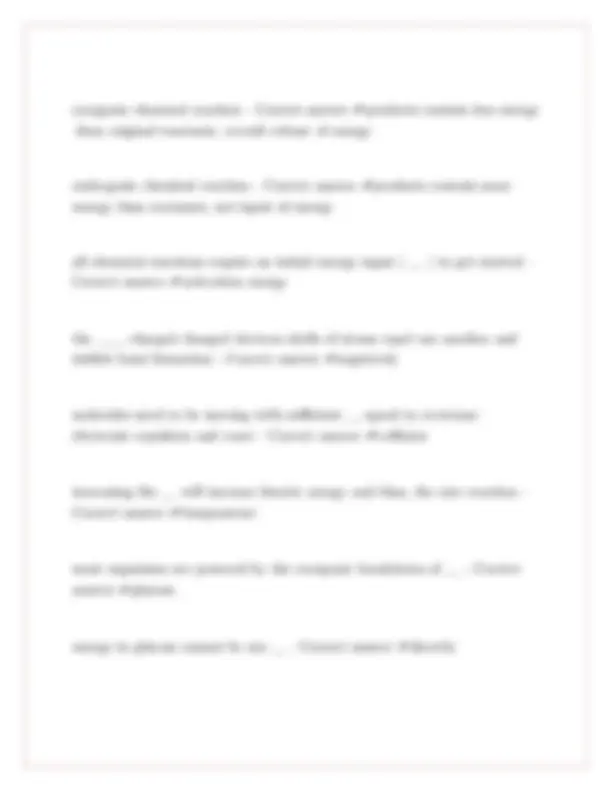
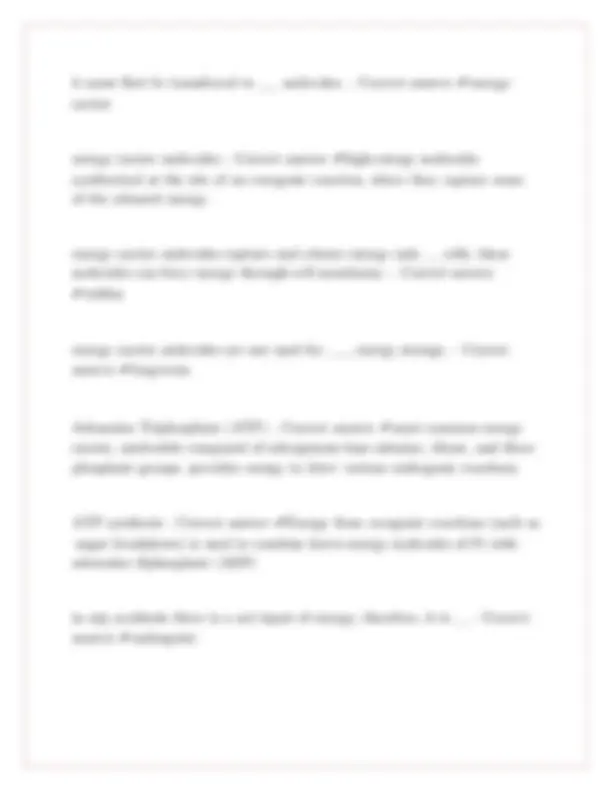
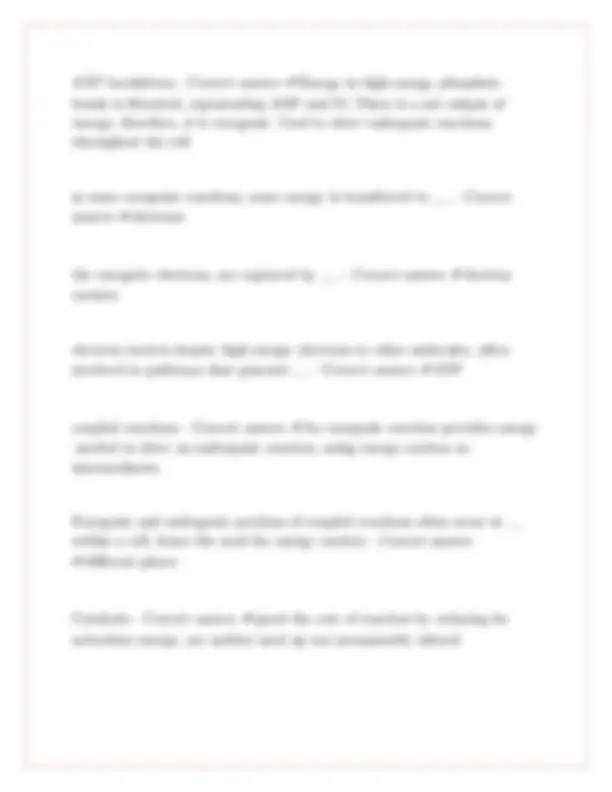
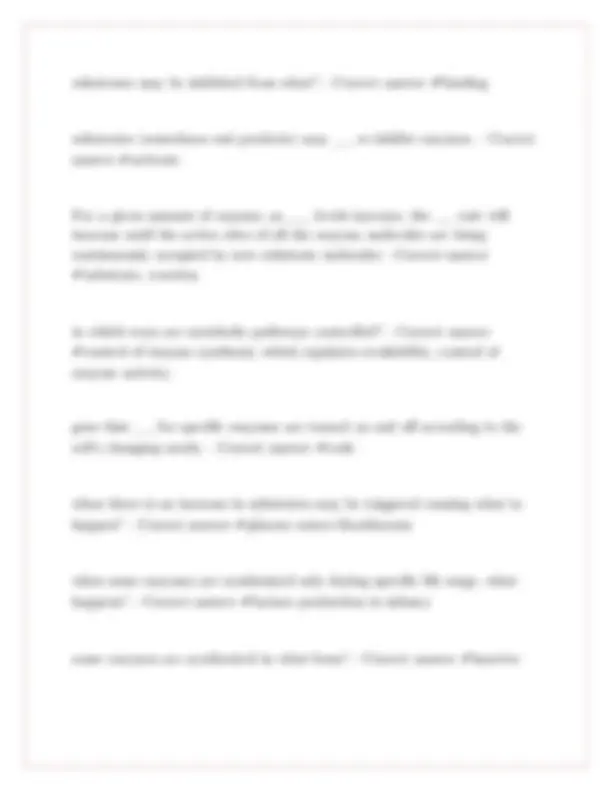
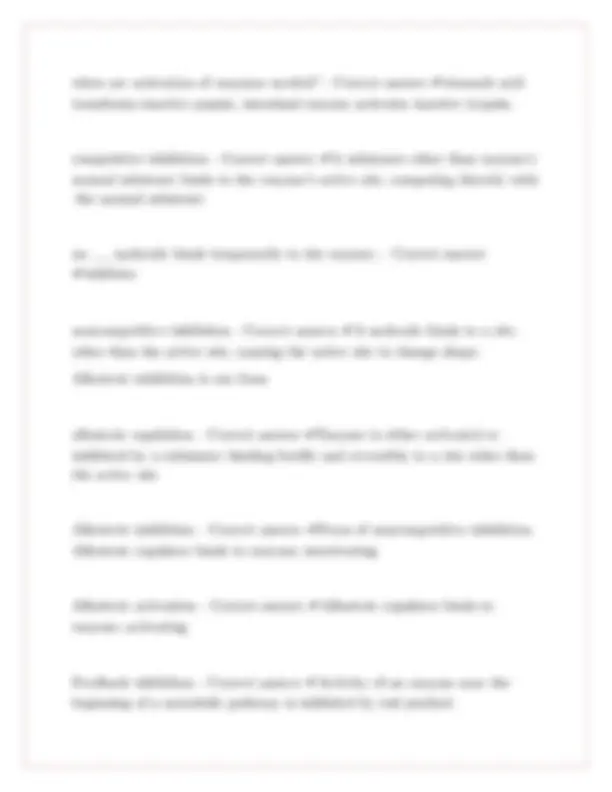
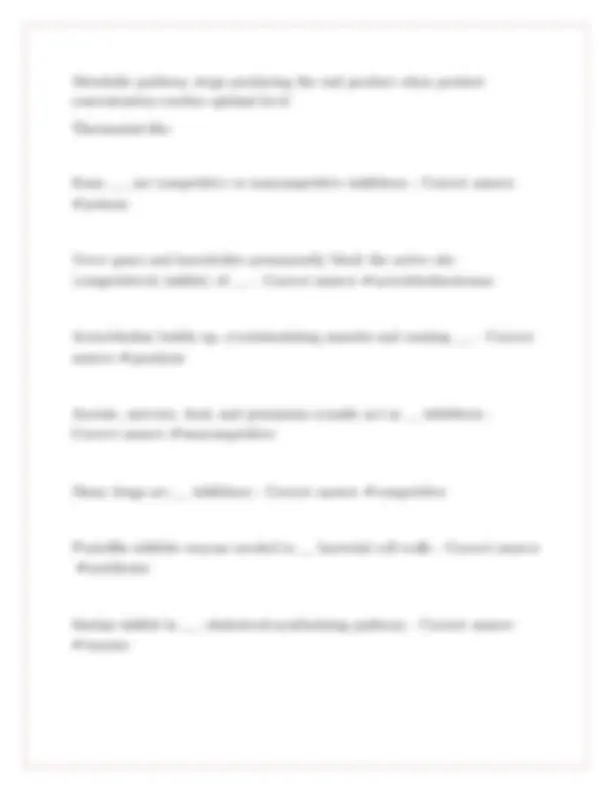
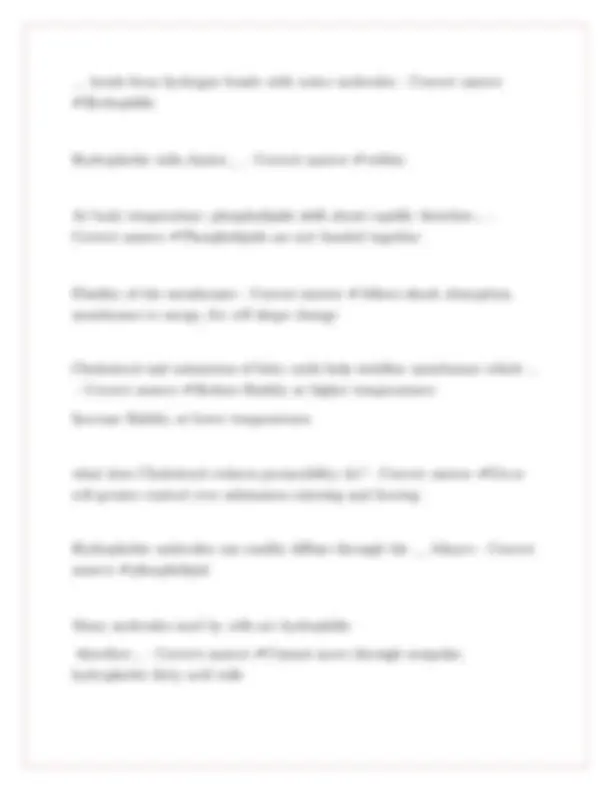
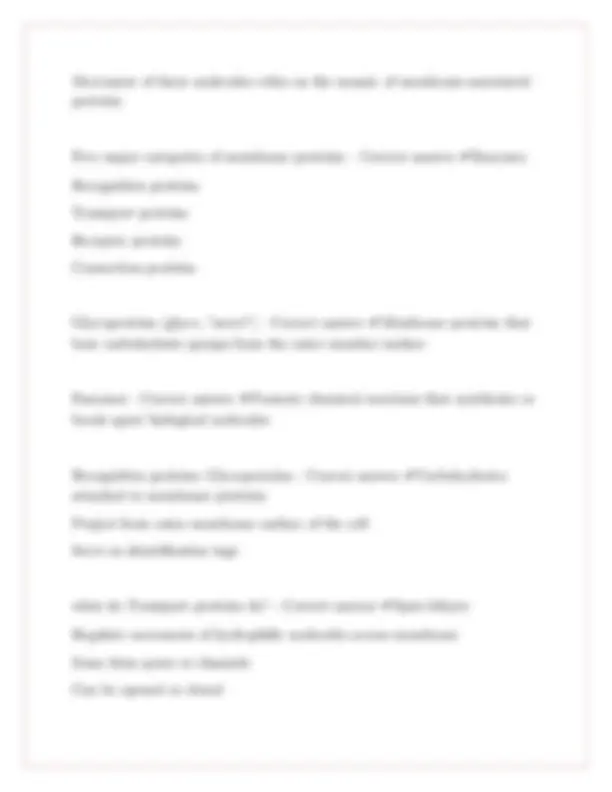
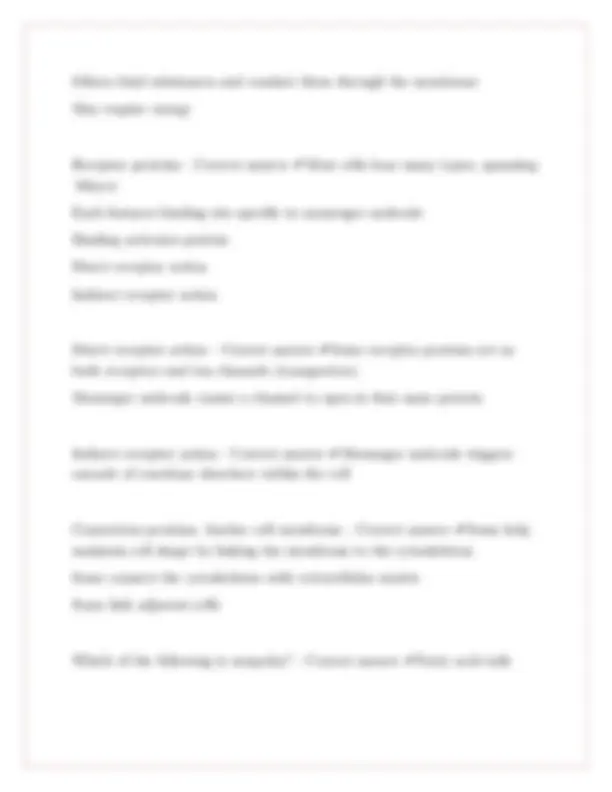

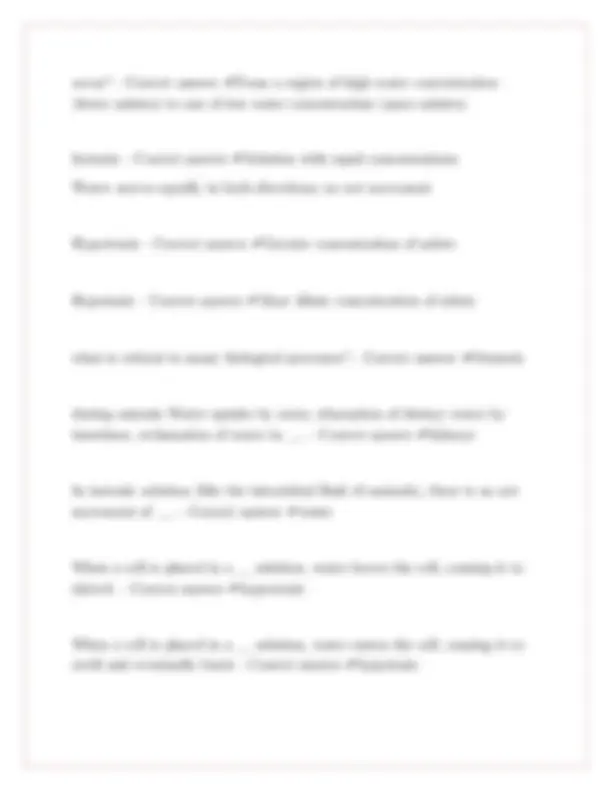
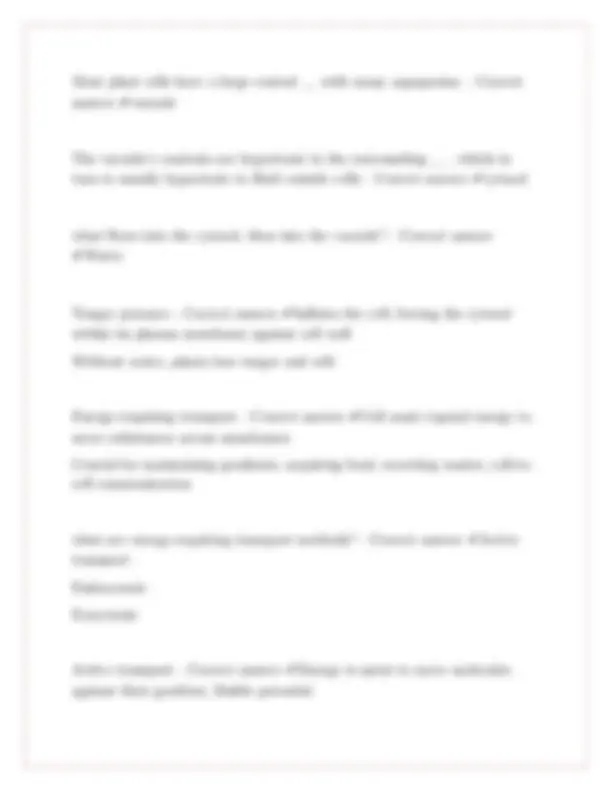
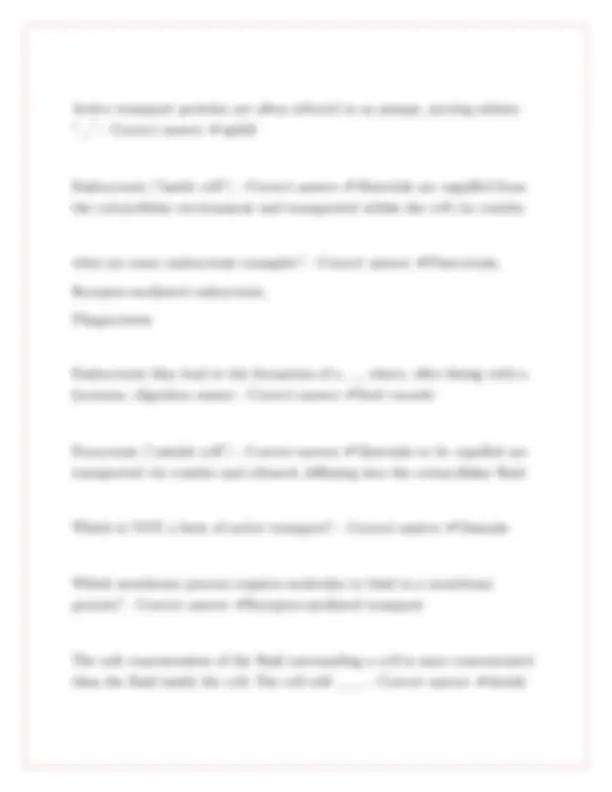
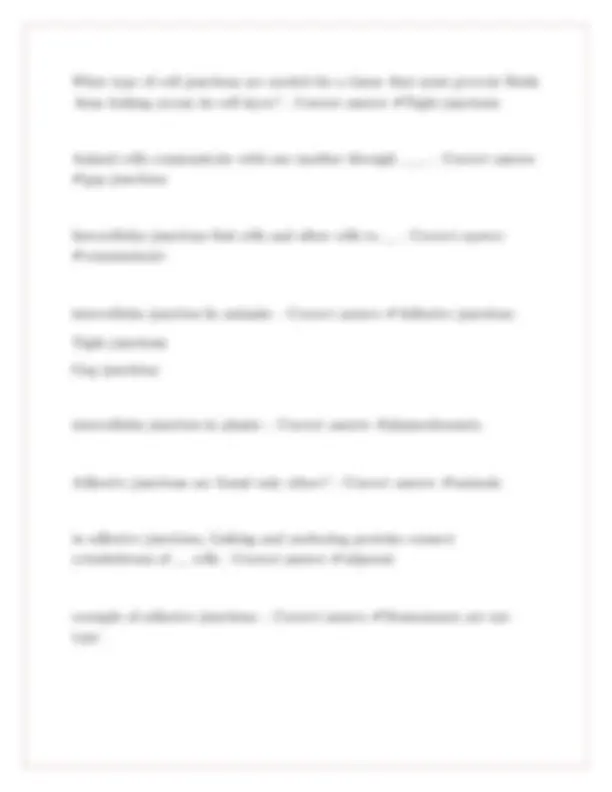

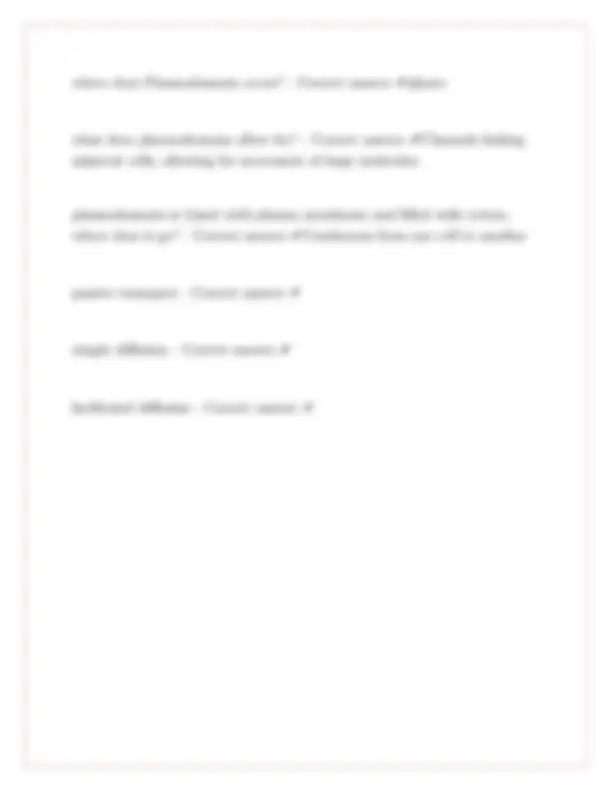


Study with the several resources on Docsity

Earn points by helping other students or get them with a premium plan


Prepare for your exams
Study with the several resources on Docsity

Earn points to download
Earn points by helping other students or get them with a premium plan
Community
Ask the community for help and clear up your study doubts
Discover the best universities in your country according to Docsity users
Free resources
Download our free guides on studying techniques, anxiety management strategies, and thesis advice from Docsity tutors
BIO 1001 latoya paul exam 2 with precise detailed answers
Typology: Exams
1 / 24

This page cannot be seen from the preview
Don't miss anything!

















Cell |! common |! features |! - |! Correct |! answer |! ✔plasma |! membrane, |! cytoplasm, |! DNA |! as |! hereditary |! blueprint, |! RNA |! to |! copy |! the |! genetic |! blueprint |! and |! guide |! construction |! of |! protiens Energy |! - |! Correct |! answer |! ✔capacity |! to |! do |! work, |! available |! in |! bonds |! of |! molecules, |! potential |! and |! kinetic work |! - |! Correct |! answer |! ✔the |! transfer |! of |! energy |! to |! an |! object |! by |! using |! a |! force |! that |! causes |! it |! to |! move potential |! energy |! - |! Correct |! answer |! ✔stored |! energy, |! includes |! chemical |! energy. kinetic |! energy |! - |! Correct |! answer |! ✔energy |! of |! movement, |! radiant under |! the |! right |! conditions, |! ___ |! and |! ___ |! energy |! can |! be |! interconverted |! - |! Correct |! answer |! ✔potential, |! kinetic
first |! law |! of |! thermodynamics |! or |! the |! law |! of |! conservation |! of |! energy. |! - |! Correct |! answer |! ✔energy |! can |! neither |! be |! created |! nor |! destroyed, |! within |! closed |! or |! isolated |! systems, |! total |! amount |! is |! unchanged second |! law |! of |! thermodynamics |! - |! Correct |! answer |! ✔energy |! conversion |! proceeds |! from |! more |! useful |! to |! less |! useful |! forms, |! not |! 100% |! efficient, |! when |! potential |! energy |! of |! gas |! is |! converted |! to |! move |! a |! car. |! lost |! has |! heat. Entropy |! - |! Correct |! answer |! ✔whenever |! energy |! is |! used, |! complexity |! and |! organized |! are |! lost, |! same |! number |! of |! atoms |! but |! overall |! increase |! in |! simple |! product |! molecule, |! energy |! must |! be |! added |! to |! the |! system |! to |! restore |! order. living |! things |! use |! the |! continuous |! influx |! of |! ______ |! from |! the |! sun |! to |! create |! low- entropy |! condition |! of |! life. |! - |! Correct |! answer |! ✔light |! energy in |! creating |! _____ |! in |! the |! form |! of |! sunlight, |! the |! sun |! also |! produces |! vast |! entropy |! as |! heat. |! - |! Correct |! answer |! ✔kinetic |! energy chemical |! reaction |! - |! Correct |! answer |! ✔process |! that |! breaks |! and |! forms |! the |! chemical |! bonds |! that |! hold |! atoms |! together. chemical |! reactions |! convert |! one |! combination |! of |! molecules, |! ___ |! into |! different |! molecules, |! ___ |! - |! Correct |! answer |! ✔reactants, |! products all |! ___ |! transfer |! energy |! and |! release |! some |! heat. |! - |! Correct |! answer |! ✔chemical |! reactions
it |! must |! first |! be |! transferred |! to |! ____ |! molecules. |! - |! Correct |! answer |! ✔energy- carrier energy |! carrier |! molecules |! - |! Correct |! answer |! ✔high-energy |! molecules |! synthesized |! at |! the |! site |! of |! an |! exergonic |! reaction, |! where |! they |! capture |! some |! of |! the |! released |! energy. energy |! carrier |! molecules |! capture |! and |! release |! energy |! only |! ___ |! cells. |! these |! molecules |! can |! ferry |! energy |! through |! cell |! membrane. |! - |! Correct |! answer |! ✔within energy |! carrier |! molecules |! are |! not |! used |! for |! _____ |! energy |! storage. |! - |! Correct |! answer |! ✔long-term Adenosine |! Triphosphate |! (ATP) |! - |! Correct |! answer |! ✔most |! common |! energy |! carrier, |! nucleotide |! composed |! of |! nitrogenous |! base |! adenine, |! ribose, |! and |! three |! phosphate |! groups. |! provides |! energy |! to |! drive |! various |! endergonic |! reactions. ATP |! synthesis |! - |! Correct |! answer |! ✔Energy |! from |! exergonic |! reactions |! (such |! as |! sugar |! breakdown) |! is |! used |! to |! combine |! lower-energy |! molecules |! of |! Pi |! with |! adenosine |! diphosphate |! (ADP) in |! atp |! synthesis |! there |! is |! a |! net |! input |! of |! energy; |! therefore, |! it |! is |! ___ |! - |! Correct |! answer |! ✔endergonic
ATP |! breakdown |! - |! Correct |! answer |! ✔Energy |! in |! high-energy |! phosphate |! bonds |! is |! liberated, |! regenerating |! ADP |! and |! Pi. |! There |! is |! a |! net |! output |! of |! energy; |! therefore, |! it |! is |! exergonic. |! Used |! to |! drive |! endergonic |! reactions |! throughout |! the |! cell in |! some |! exergonic |! reactions, |! some |! energy |! is |! transferred |! to |! ___. |! - |! Correct |! answer |! ✔electrons the |! energetic |! electrons, |! are |! captured |! by |! ___. |! - |! Correct |! answer |! ✔electron |! carriers electron |! carriers |! donate |! high-energy |! electrons |! to |! other |! molecules, |! often |! involved |! in |! pathways |! that |! generate |! ___ |! - |! Correct |! answer |! ✔ATP coupled |! reactions |! - |! Correct |! answer |! ✔An |! exergonic |! reaction |! provides |! energy |! needed |! to |! drive |! an |! endergonic |! reaction, |! using |! energy |! carriers |! as |! intermediaries Exergonic |! and |! endergonic |! portions |! of |! coupled |! reactions |! often |! occur |! in |! ___ |! within |! a |! cell, |! hence |! the |! need |! for |! energy |! carriers |! - |! Correct |! answer |! ✔different |! places Catalysts |! - |! Correct |! answer |! ✔speed |! the |! rate |! of |! reaction |! by |! reducing |! its |! activation |! energy, |! are |! neither |! used |! up |! nor |! permanently |! altered
metabolic |! pathway |! - |! Correct |! answer |! ✔sequence |! of |! linked |! metabolic |! reactions, |! starting |! reactant |! molecule |! is |! converted, |! via |! an |! enzyme, |! into |! an |! intermediary, |! which |! is |! converted, |! via |! another |! enzyme, |! to |! a |! second |! intermediary, |! and |! so |! on |! until |! an |! end |! product |! is |! produced photosynthesis |! and |! glucose |! breakdown |! are |! examples |! of? |! - |! Correct |! answer |! ✔metabolic |! pathways different |! metabolic |! pathways |! often |! involve |! some |! of |! the |! same |! ___. |! - |! Correct |! answer |! ✔molecules thousands |! of |! metabolic |! pathways |! are |! directly |! or |! indirectly |! ___. |! - |! Correct |! answer |! ✔interconnected what |! is |! influenced |! by |! the |! concentration |! of |! enzymes, |! substrate, |! or |! both? |! - |! Correct |! answer |! ✔reaction |! rate what |! must |! regulate |! when |! and |! at |! what |! rate |! reactions |! occur, |! even |! when |! concentrations |! fluctuate? |! - |! Correct |! answer |! ✔living |! cells what |! are |! codes |! for |! enzymes |! may |! be |! turned |! on |! or |! off? |! - |! Correct |! answer |! ✔genes enzymes |! may |! be |! synthesized |! in |! what |! form? |! - |! Correct |! answer |! ✔inactive
substrates |! may |! be |! inhibited |! from |! what? |! - |! Correct |! answer |! ✔binding substrates |! (sometimes |! end |! products) |! may |! ____ |! or |! inhibit |! enzymes. |! - |! Correct |! answer |! ✔activate For |! a |! given |! amount |! of |! enzyme, |! as |! _____ |! levels |! increase, |! the |! ____ |! rate |! will |! increase |! until |! the |! active |! sites |! of |! all |! the |! enzyme |! molecules |! are |! being |! continuously |! occupied |! by |! new |! substrate |! molecules |! - |! Correct |! answer |! ✔substrate, |! reaction in |! which |! ways |! are |! metabolic |! pathways |! controlled? |! - |! Correct |! answer |! ✔control |! of |! enzyme |! synthesis, |! which |! regulates |! availability, |! control |! of |! enzyme |! activity. gene |! that |! ____ |! for |! specific |! enzymes |! are |! turned |! on |! and |! off |! according |! to |! the |! cell's |! changing |! needs. |! - |! Correct |! answer |! ✔code when |! there |! is |! an |! increase |! in |! substrates |! may |! be |! triggered |! causing |! what |! to |! happen? |! - |! Correct |! answer |! ✔glucose |! enters |! bloodstream when |! some |! enzymes |! are |! synthesized |! only |! during |! specific |! life |! stage, |! what |! happens? |! - |! Correct |! answer |! ✔lactase |! production |! in |! infancy some |! enzymes |! are |! synthesized |! in |! what |! form? |! - |! Correct |! answer |! ✔inactive
Metabolic |! pathway |! stops |! producing |! the |! end |! product |! when |! product |! concentration |! reaches |! optimal |! level Thermostat-like Some |! ____ |! are |! competitive |! or |! noncompetitive |! inhibitors |! - |! Correct |! answer |! ✔poisons Nerve |! gases |! and |! insecticides |! permanently |! block |! the |! active |! site |! (competitively |! inhibit) |! of |! ___. |! - |! Correct |! answer |! ✔acetylcholinesterase Acetylcholine |! builds |! up, |! overstimulating |! muscles |! and |! causing |! ___. |! - |! Correct |! answer |! ✔paralysis Arsenic, |! mercury, |! lead, |! and |! potassium |! cyanide |! act |! as |! ___ |! inhibitors |! - |! Correct |! answer |! ✔noncompetitive Many |! drugs |! are |! ___ |! inhibitors |! - |! Correct |! answer |! ✔competitive Penicillin |! inhibits |! enzyme |! needed |! to |! ___ |! bacterial |! cell |! walls |! - |! Correct |! answer |! ✔synthesize Statins |! inhibit |! in |! ____ |! cholesterol-synthesizing |! pathway |! - |! Correct |! answer |! ✔enzyme
Aspirin |! and |! ibuprofen |! inhibit |! enzyme |! involved |! in |! ___,____,____ |! - |! Correct |! answer |! ✔swelling, |! pain, |! and |! fever Many |! anticancer |! drugs |! inhibit |! enzymes |! required |! to |! duplicate |! ____ |! (in |! actively |! dividing |! cells |! of |! patient |! as |! well) |! - |! Correct |! answer |! ✔DNA Environmental |! conditions |! influence |! ___. |! - |! Correct |! answer |! ✔enzyme |! activity Three-dimensional |! structure |! of |! an |! enzyme |! is |! sensitive |! to____ |! and |! temperature |! - |! Correct |! answer |! ✔pH When |! outside |! the |! proper |! range, |! the |! enzyme |! becomes |! ___ |! - |! Correct |! answer |! ✔denatured Loss |! of |! exact |! three-dimensional |! structure |! is |! required |! for |! proper_____ |! - |! Correct |! answer |! ✔functioning what |! (refrigeration, |! freezing, |! salt) |! slows |! enzyme-catalyzed |! reactions |! that |! allow |! bacteria |! and |! fungi |! to |! grow |! and |! reproduce? |! - |! Correct |! answer |! ✔Preservation All |! the |! membranes |! of |! a |! cell |! have |! a |! similar |! basic |! structure |! - |! Correct |! answer |! ✔Proteins |! suspended |! in |! or |! attached |! to |! phospholipid |! bilayer Otherwise, |! membranes |! differ |! among |! tissue |! types |! and |! environments
___ |! heads |! form |! hydrogen |! bonds |! with |! water |! molecules |! - |! Correct |! answer |! ✔Hydrophilic Hydrophobic |! tails |! cluster___ |! - |! Correct |! answer |! ✔within At |! body |! temperature, |! phospholipids |! shift |! about |! rapidly |! therefore... |! - |! Correct |! answer |! ✔Phospholipids |! are |! not |! bonded |! together Fluidity |! of |! the |! membranes |! - |! Correct |! answer |! ✔Allows |! shock |! absorption, |! membranes |! to |! merge, |! for |! cell |! shape |! change Cholesterol |! and |! saturation |! of |! fatty |! acids |! help |! stabilize |! membranes |! which |! ... |! - |! Correct |! answer |! ✔Reduce |! fluidity |! at |! higher |! temperatures Increase |! fluidity |! at |! lower |! temperatures what |! does |! Cholesterol |! reduces |! permeability |! do? |! - |! Correct |! answer |! ✔Gives |! cell |! greater |! control |! over |! substances |! entering |! and |! leaving Hydrophobic |! molecules |! can |! readily |! diffuse |! through |! the |! ___ |! bilayer |! - |! Correct |! answer |! ✔phospholipid Many |! molecules |! used |! by |! cells |! are |! hydrophilic |! |! therefore... |! - |! Correct |! answer |! ✔Cannot |! move |! through |! nonpolar, |! hydrophobic |! fatty |! acid |! tails
Movement |! of |! these |! molecules |! relies |! on |! the |! mosaic |! of |! membrane-associated |! proteins Five |! major |! categories |! of |! membrane |! proteins: |! - |! Correct |! answer |! ✔Enzymes Recognition |! proteins Transport |! proteins Receptor |! proteins Connection |! proteins Glycoproteins |! (glyco, |! "sweet") |! - |! Correct |! answer |! ✔Membrane |! proteins |! that |! bear |! carbohydrate |! groups |! from |! the |! outer |! member |! surface Enzymes |! - |! Correct |! answer |! ✔Promote |! chemical |! reactions |! that |! synthesize |! or |! break |! apart |! biological |! molecules Recognition |! proteins: |! Glycoproteins |! - |! Correct |! answer |! ✔Carbohydrates |! attached |! to |! membrane |! proteins Project |! from |! outer |! membrane |! surface |! of |! the |! cell Serve |! as |! identification |! tags what |! do |! Transport |! proteins |! do? |! - |! Correct |! answer |! ✔Span |! bilayer Regulate |! movement |! of |! hydrophilic |! molecules |! across |! membrane Some |! form |! pores |! or |! channels Can |! be |! opened |! or |! closed
An |! organism |! living |! at |! the |! equator |! has |! more |! saturated |! phospholipids |! in |! its |! cell |! membranes |! than |! an |! organism |! living |! at |! the |! South |! Pole. |! Why? |! - |! Correct |! answer |! ✔In |! cold |! climates, |! more |! unsaturated |! fats |! with |! kinked |! tails |! are |! needed |! to |! maintain |! the |! fluidity |! of |! the |! cell |! membranes. The |! phospholipid |! tails |! of |! a |! cell |! membrane |! face |! one |! another |! because |! _____. |! - |! Correct |! answer |! ✔they |! are |! hydrophobic—repelled |! by |! water Solute |! - |! Correct |! answer |! ✔sustance |! that |! can |! be |! dissolved |! (dispersed |! into |! individual |! atoms, |! molecules, |! or |! ions) |! in |! a |! solvent Solvent |! - |! Correct |! answer |! ✔fluid |! capable |! of |! dissolving |! a |! solute Concentration |! - |! Correct |! answer |! ✔amount |! of |! solute |! in |! a |! given |! volume |! of |! solvent Gradient |! - |! Correct |! answer |! ✔difference |! in |! certain |! property |! (temperature, |! pressure, |! charge, |! concentration) |! between |! two |! adjacent |! regions Diffusion |! - |! Correct |! answer |! ✔Net |! movement |! of |! solutes |! from |! regions |! of |! high |! concentration |! to |! regions |! of |! low |! concentration, |! or |! "down" |! their |! concentration |! gradient Produced, |! over |! time, |! by |! motion |! of |! solutes Eventually |! solutes |! will |! be |! evenly |! dispersed Sped |! by |! increasing |! concentration |! gradient |! or |! temperature
Cells |! must |! generate |! and |! maintain |! ___ |! to |! stay |! alive |! - |! Correct |! answer |! ✔concentration |! gradients Plasma |! membranes |! are |!? |! - |! Correct |! answer |! ✔selectively |! permeable selectively |! permeable |! - |! Correct |! answer |! ✔Proteins |! allow |! only |! specific |! solutes |! to |! permeate, |! helping |! maintain |! concentration |! gradients Substances |! are |! allowed |! to |! permeate |! in |! two |! ways |! - |! Correct |! answer |! ✔Passive |! transport Energy-requiring |! transport Passive |! transport: |! - |! Correct |! answer |! ✔diffusion |! of |! substances |! down |! their |! concentration |! gradient. |! Diffusion |! of |! substances |! down |! their |! gradients. |! Does |! not |! require |! energy. |! Includes Simple |! diffusion |! Facilitated |! diffusion Osmosis Energy-requiring |! transport: |! - |! Correct |! answer |! ✔cell |! must |! expend |! energy |! to |! move |! substances |! across |! membranes Simple |! diffusion |! - |! Correct |! answer |! ✔Direct |! diffusion |! through |! the |! phospholipid |! bilayer Very |! small |! molecules |! with |! no |! net |! charge. Lipid-soluble |! molecules
occur? |! - |! Correct |! answer |! ✔From |! a |! region |! of |! high |! water |! concentration |! (fewer |! solutes) |! to |! one |! of |! low |! water |! concentration |! (more |! solutes) Isotonic |! - |! Correct |! answer |! ✔Solution |! with |! equal |! concentrations Water |! moves |! equally |! in |! both |! directions; |! no |! net |! movement Hypertonic |! - |! Correct |! answer |! ✔Greater |! concentration |! of |! solute Hypotonic |! - |! Correct |! answer |! ✔More |! dilute |! concentration |! of |! solute what |! is |! critical |! to |! many |! biological |! processes? |! - |! Correct |! answer |! ✔Osmosis during |! osmosis |! Water |! uptake |! by |! roots, |! absorption |! of |! dietary |! water |! by |! intestines, |! reclamation |! of |! water |! in |! ___. |! - |! Correct |! answer |! ✔kidneys In |! isotonic |! solution |! (like |! the |! interstitial |! fluid |! of |! animals), |! there |! is |! no |! net |! movement |! of |! ___. |! - |! Correct |! answer |! ✔water When |! a |! cell |! is |! placed |! in |! a |! ___ |! solution, |! water |! leaves |! the |! cell, |! causing |! it |! to |! shrivel. |! - |! Correct |! answer |! ✔hypertonic When |! a |! cell |! is |! placed |! in |! a |! ___ |! solution, |! water |! enters |! the |! cell, |! causing |! it |! to |! swell |! and |! eventually |! burst |! - |! Correct |! answer |! ✔hypotonic
Most |! plant |! cells |! have |! a |! large |! central |! ___ |! with |! many |! aquaporins. |! - |! Correct |! answer |! ✔vacuole The |! vacuole's |! contents |! are |! hypertonic |! to |! the |! surrounding |! ___ |! , |! which |! in |! turn |! is |! usually |! hypertonic |! to |! fluid |! outside |! cells |! - |! Correct |! answer |! ✔cytosol what |! flows |! into |! the |! cytosol, |! then |! into |! the |! vacuole? |! - |! Correct |! answer |! ✔Water Turgor |! pressure |! - |! Correct |! answer |! ✔Inflates |! the |! cell, |! forcing |! the |! cytosol |! within |! its |! plasma |! membrane |! against |! cell |! wall Without |! water, |! plants |! lose |! turgor |! and |! wilt Energy-requiring |! transport |! - |! Correct |! answer |! ✔Cell |! must |! expend |! energy |! to |! move |! substances |! across |! membranes Crucial |! for |! maintaining |! gradients, |! acquiring |! food, |! excreting |! wastes, |! cell-to- cell |! communication what |! are |! energy-requiring |! transport |! methods? |! - |! Correct |! answer |! ✔Active |! transport Endocytosis Exocytosis Active |! transport |! - |! Correct |! answer |! ✔Energy |! is |! spent |! to |! move |! molecules |! against |! their |! gradient, |! Builds |! potential